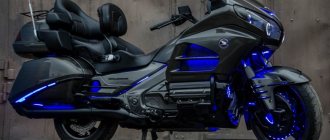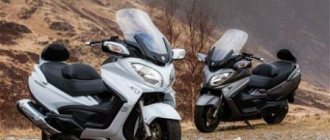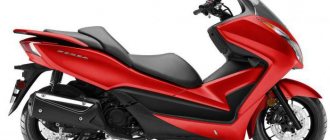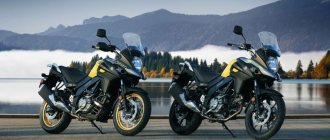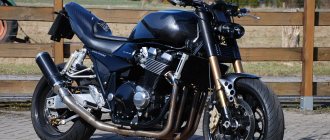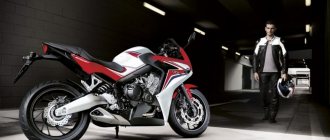Fast civilian or near-sport motorcycles are not always convenient in everyday life. As practice shows, relatively low-speed maxi-scooters in the city and on the highway are many times superior to the vast majority of motorcycles in terms of comfort and traffic intensity. Today we’ll look at the trendsetters of the genre - as a vehicle with mileage and history, let’s take the Honda FJS 600 Silver Wing of the 2001-2008 model, and as a current analogue - the most modern existing Suzuki AN 650 Burgman.
Honda FJS 600 Silver Wing (2001–2008, RUB 120,000–300,000)
The first generation Silver Wing in the 600 cc version is one of the most popular and in demand maxi-scooters. The model has long been discontinued, but the popularity of the Japanese “sofa” with a memorable diamond-shaped headlight has only grown over the years.
Engine
The 582cc eight-valve parallel twin with electronically controlled fuel injection and liquid cooling is fantastically reliable. It does not consume oil even in the most advanced cases. No sores or weak points were noticed. With adequate maintenance, the engine can easily last 100,000–150,000 km without major repairs.
Transmission
The CVT transmission is designed as is, with absolutely no bells and whistles. Which has a positive effect on resource and reliability. The mechanism is similar to that of a fifty-kopeck scooter. Weights, pulleys and belt. Nothing more! The result is a non-violent character (for fans of dynamics, it makes sense to sharpen their skis in the direction of expensive tuning), which is more than compensated by reliability that borders on the fantastic.
Frame and body kit
At the current time, the frame design can already be called obsolete. The spatial steel part does not have sufficient rigidity, which does not have the best effect on handling.
Silver's plastic is dense and thick. The abundance of mounting eyes is not the best for long-term use. Fasteners often suffer during repairs; plastic parts begin to rattle and join with an uneven gap.
Brakes
The braking system is Silver's strong point. Despite the absence of a second brake disc on the front wheel. All 600 cars are equipped with a combined brake force distribution system. When you press the front brake lever, the two pistons of the front caliper are activated. Pressing the rear brake lever activates one front caliper piston and two rear caliper pistons.
Pendants
The chassis of the Honda FJS 600 Silver Wing, so to speak, is designed strictly according to scooter canons. Without introducing solutions from the world of cubic motorcycles. The fork is short and flimsy, without additional yokes. Hence the lack of rigidity, which, together with a not very monumental frame and a simple rear suspension with two shock absorbers, reduces the “driver’s” to a minimum. The suspension is generally strong and reliable, but unlike many competitors, it is not conducive to active, almost sporty driving. It is worth paying attention to the mounting ears of the rear shock absorbers and the engine-frame “rocker”. Driving on roads of poor quality may cause serious gaps and cracks in these places.
Comfort
The standard windshield on the Honda FJS 600 Silver Wing is large, but not adjustable. Tall drivers will have to order aftermarket windshields or additional add-on sections. The suspension, despite its incapacity for hyperactive steering on uneven surfaces, behaves extremely adequately. The scooter passes through potholes, joints and other misunderstandings smoothly and softly. Tall drivers may feel uncomfortable driving the Silver. An individual with a height of over 190 cm is guaranteed to rest his knees on the front panel.
Modifications
Silver Wing debuted in 2000. There are two cubic capacity options at once - 400 cm3 and 600 cm3. In 2002, the relay regulator was moved under the fairing. In 2003, a “Mode” button appeared, allowing you to slightly “cheer up” the injection maps, and ABS also appeared as an option. In 2004, a slight restyling took place - the shape and fastening of the glove compartment lids changed, the headlight reflector housing became chrome-plated, the material of the seat upholstery changed, the instrument panel lighting became brighter, the lower fork cups and rims began to be painted black. In 2006, an immobilizer and side lamps in the headlight appeared, and the display backlight on the dashboard became blue. In 2008, Honda polished up the Silver for the last time before the generation change. Distinctive features are gold-colored wheels, calipers and nameplates, as well as carbon-fibre seat trim. In 2009, the design was radically updated, and changes were made to the engine.
Test drive Honda Silver Wing 600, Suzuki Burgman 650
The information presented in this article is based not on a momentary acquaintance with both maxiscooters (called “sofas”) and their technical characteristics, as is often the case during tests, but on long-term experience in operating each of them. Having driven more than 16 thousand kilometers on the 2003 AN 650 SkyWave (the Japanese name for Burgman) over the past season, I was able to test it in almost all kinds of conditions. We covered highways, Crimean serpentines, off-road roads and, of course, thousands of kilometers through our beloved Kyiv - the city of chestnuts and traffic jams. But, unexpectedly for myself, when choosing a two-wheeled friend for the new 2007 season, my choice fell on the Honda SilverWing 600. At the time of writing this review, the SilverWing had already traveled with me about 10 thousand kilometers. There is quite a lot of information to write this article, so I will try to outline everything that may be useful to you when choosing between these two beauties.
The differences between both scooters made themselves felt immediately after purchasing the SilverWing 600. The first ones were sharply negative. One of the minuses of Silver is the mirrors. Burgman's are definitely better, both in size and location. Another is the feeling of lack of dynamics when accelerating the Honda. But, 20 minutes after the first running kilometers, clear advantages were revealed. The tall Givi windshield installed on the device I received was definitely an advantage in comparison with the “narrow” one, which was too short and did not protect enough from the headwind. The passenger especially felt this. It was also impossible not to note the absolute comfort of the Honda when driving over bumps and light potholes on the roads, where the Susa’s suspension gave up and sometimes went all the way.
After a month (after getting used to the device), the positive aspects began to arrive, and I decided on the first experiment - I replaced the stock variator with a Malossi Multivar 2000 (costing about 200 euros). This miracle of Italian engineering includes the CVT itself and two sets of rollers weighing 21 and 24 grams (while standard Honda rollers weigh 28 grams each). After experimenting, I decided to install rollers from both sets mixed - one 21 grams, one 24 grams. As one would expect, the intensity of acceleration to 100 km/h increased noticeably, and I got what I was sorely missing. Moreover, in occasional competitions with the AN650 on the road, it was always possible to immediately leave them behind with a gradual increase in the lead. But this is provided that the Burgman was driving in normal mode, without the magic “Power” button turned on. When this button is turned on, the Suzuki becomes noticeably faster...
In appearance, the Burgman is still a “ponto-launcher”, and it looks decidedly better due to the side lights placed on the front of the rear-view mirrors. But the Honda from the front looks no worse. From this perspective, it is a pure sportbike, with the shape of the headlight most reminiscent of the “sport” Suzuki GSX-R.
Having conducted a cross-sectional survey among the motorcycle and non-motorcycle public, I also realized that opinions on “who looks better” are divided approximately in half, so, as they say, “it depends on taste and color...”.
The Suzuki weighs more, but feels much more. I considered this factor an advantage for myself, because I really like this heaviness in my hands. But I heard the opposite from some Burgman drivers...
The engine design of both scooters is admirable, especially the “combine” design of the AN650. But I probably wouldn’t disassemble it in the field in case of an unexpected breakdown, and that says it all. In addition, materials on the Internet found in various sources, and the experience of a real “overhaul” of more than 20 models of each of these devices indicate that various “sores” of the engine or transmission in Suzuki were detected much more often.
After inspecting the Honda's CVT compartment at 10,000 km, I was surprised to discover that the belt, clutch and CVT were in almost perfect condition, which, however, I attributed to the neatness or cowardice of the previous Japanese owner.
Both engines are two-cylinder, water-cooled. Suzukovsky, however, works noticeably louder. Honda's transmission drive is CVT, while Suzuki's is automatic or semi-automatic (5-speed gearbox that automatically shifts up or down if the crankshaft speed approaches extreme values).
Turning on the Burgman's "Power" button is only possible in automatic gear shift mode. This is a very convenient solution that I used when I needed to make an operational maneuver, especially in the hustle and bustle of city traffic. The principle of its operation: the engine control unit will keep the speed in the zone close to maximum power and change gears accordingly. Gasoline consumption undoubtedly increases, but the result of driving with the option enabled is impressive. A similar button appeared on the 600th Silver Wing, starting with the 2006 model, but I have not yet had the opportunity to test it.
From many acquaintances of “Hondovods” we have heard about an incomprehensible “failure” at a speed of 80-90 km/h, when, with the gas handle turned off, the scooter seems to “choke” until it passes the mark of 105-110 km/h. But, as mentioned above, with the installation of the Malossi variator on the Honda, I forgot about the advantages of the Suzuki in acceleration and dynamics.
When it comes to suspension performance, Honda is the undisputed leader. Firstly, high ground clearance and a larger tire tread give the Silver undeniable advantages in uneven conditions on our roads. Secondly, on the same pits with similar hard shock absorber settings and equally serviceable forks, the Honda does not throw so much, and it turned out to be much easier to get out of the unexpected “sausage” obtained in this way. In addition, there is an opinion about the short life span of Burgman wheel bearings. Agree, this is also an important factor, especially after reading the complaints to Suzuki service centers in Europe, where some devices had their bearings replaced after the first 5 thousand kilometers! By the way, when installing Michelin Pilot Sport tires on the Burgman, cornering it into incredibly sharp corners becomes quite easy. Although I must note that Honda behaves no worse with standard Danlop.
There are no complaints about the brakes. Both scooters showed excellent braking results. Moreover, they are approximately the same, despite the fact that Honda has one brake disc at the front and rear, and Suzuki has one more at the front.
During the first kilometers, the Honda got the impression that it was “eating” more gasoline. But, as measurements showed, it was only the last strip of the fuel level scale in the tank blinking too early. Watching this blinking, I managed to drive more than 30 km to a gas station. In general, with skillful control of the Honda at various speeds, the consumption is absolutely identical to that of the Suzuki, although the advantages of the gearbox cannot but be attributed to the “pluses” of the AN650. Another observation: Honda turned out to be less demanding of domestic gasoline, and agrees to “eat” almost any 95-octane gasoline, while in order to achieve optimal performance, the Burgman had to fill it with “95+ premium”, and Shell gas stations ", "TNK" and "Lukoil" were experimentally rejected (based on dynamic characteristics and the amount of subsequent kilometers traveled before the next refueling).
It is definitely difficult to maneuver around the city with its numerous traffic jams on both scooters with their dimensions. The minimum speed at which it is possible not to drop the devices is a little more than 5 km/h. Windage in crosswinds is large for both devices, but due to the greater weight, the AN650 “rearranges” less, and, in my opinion, the weight in such conditions adds a little comfort. But, if the wind still “overwhelms” the scooter, then, unlike Honda, Suzuki has much less chance of returning to a vertical position.
The actual maximum speed of the AN650 is 10 km/h higher, but the comfortable cruising speed of both devices is the same - 140-165 km/h. And only on extremely smooth autobahns in windless weather can you experience what these “monsters” are capable of with the throttle cranked to the maximum.
It is difficult to name an undisputed leader in ergonomics. In terms of visibility, the Burgman wins. Its mirrors can be called an ingenious design solution, both in size, design, and location - in the same plane as the dashboard. This is very convenient: you don’t have to switch your peripheral vision between the instrument panel and the mirrors, as is the case with the Honda. I have to admit that on the Honda I began to look in the mirrors less often and turn around more often. In addition, in addition to the insufficient area, the Silver Wing mirrors have another drawback - they vibrate, but this was cured by installing heavier steering dampers.
The Suzuki dashboard, with the exception of the not very readable tachometer, did not cause any complaints - everything is very informative, readable and convenient. Honda designers lost slightly in this regard.
Silver's high windshield allows the driver and passenger to feel as comfortable as possible, especially in comparison with the Burgman's passenger seat, where comfort is hampered by the turbulence of the air flow, which even at a speed of about 120 km/h does not cause the most pleasant sensations. Even “in the state”, the “Silver” windshield is higher than that of the Burgman 2003 model year, but Suzuki designers have already equipped newer models with height-adjustable glass.
In both cases, the seats of the compared models, which can rightfully be called sofas, are truly royal. The comfort of placement, leg positioning and seating for both driver and passenger is at the highest level. The luggage compartment is quite spacious on both scooters, although the Susa has more. The location of the battery and access to the side lamp compartments in the Honda certainly pleased me.
And one more important factor: if you are taller than 185 cm, I do not recommend choosing a Suzuki - with my similar height, I almost rested my knees on the front panel. On the Honda there is enough reserve for any position of the legs. Moving on both scooters off-road or in sand is a disaster. When overcoming the very first 3 meters of dry sand, both devices were successfully bogged down. After which they were just as successfully pulled out with the help of three pairs of strong male hands. When overcoming obstacles in the form of wet primer or the same sand, each of the devices is worthy of a three-point mark. At the same time, in first gear in semi-automatic mode, Suzuki was a little more confident, despite the greater weight. Honda is able to overcome hilly terrain and small hills much more easily (due to the higher profile of the tires and greater ground clearance). Of course, I don’t regret switching to Honda. Firstly, another device is a huge plus to the experience. Secondly, “Silver” is a victory over the traps of Ukravtodor. Thirdly, the Honda seems to me more convenient and even easier to maintain, especially in the event of forced repairs in the field. For the near future, if the market does not provide an opportunity to switch to some interesting new product, I will focus on purchasing a 2006 Honda Silver Wing 600. To the question that I was asked very often: “Which one is better?”, I still answer: “They are different, I advise you to definitely try both.” Although in fact, I am more pleased with the Honda in domestic operating conditions.
Text: Andrey Shmyndyuk (GRUZ), MotoUA.net expert
Photo: author
Suzuki AN 650 Burgman (2013 – present, RUB 400,000–650,000)
It's hard not to notice Suzuki's passion for producing maxi-scooters. Specifically, “Burgmans” are present in all running cubic capacity ranges of 125–650 cm3. “650” is the flagship of the model range and at the same time one of the most comfortable maxi-scooters on the planet.
Engine
The strongly forward-inclined two-cylinder injection four-stroke liquid-cooled engine does not shake much with charisma, but it drives assertively and efficiently. In the world of maxi-scooters, it stands out for its impressive low-end thrust and top speed of around a record 200 km/h. This power unit produces little vibration; it begins to eat oil only in the most advanced cases. Mileages of 100,000 km or more with proper maintenance are not uncommon.
Transmission
The transmission of the Suzuki AN 650 Burgman is made according to a complex, rarely used design. The engineers who created it are great fellows, but there are, nevertheless, reasons for criticism. The classic V-belt variator in the case of the large “Burg” is equipped with an add-on in the form of electronic control via a servo drive. The electronic brain gives the scooter a quick response to turning the gas handle and efficiency. It is possible to switch to manual mode with five virtual gears, as well as switch to Power mode (analogous to sport mode). The weak point of the variator and, at the same time, the main problem of all AN 650 Burgman lies in the gear ratio control mechanism. The servo has two small all-plastic gears that interact with each other and with larger metal gears. Plastic tends to wear out and deform from high temperatures. As a result, the scooter may become immobilized at the most inopportune moment. No one can guarantee you how much longer the scooter will travel, 1000 km or 10,000 km. Repairing this sore in the field is not possible. Ideally, it makes sense to replace plastic gears with metal ones from third-party masters.
Frame and body kit
The complex steel frame and ornate steel rear subframe provide a robust design that requires no additional reinforcement. Thick plastic reliably protects the “internal organs” of the scooter in case of falls. Plastic parts in the most vulnerable areas are equipped with wear-resistant pads.
Brakes
The brakes of the Suzuki AN 650 Burgman could be the benchmark among maxi-scooters, if not for the weakness of the front and rear brake levers. This problem is solved by installing reinforced brake hoses.
Suspension
Despite the external gloss and advanced equipment, the Burgman is primitive in terms of suspension. There are no special complaints about the telescopic fork, which cannot be said about a pair of shock absorbers in the rear suspension. For such a bulky and cubic “sofa” the shock absorbers are nearly enough. Especially regarding torsional rigidity. When driving diagonally along serious irregularities, the scooter’s stern continually dances a very unpleasant dance, which can turn into a dangerous departure from the intended trajectory.
Comfort
Due to its considerable dimensions and thoughtful ergonomics, the Suzuki AN 650 Burgman comes close to luxury tourer motorcycles in terms of comfort. When driving in dense city traffic, the Burg may be too wide, but the engineers came up with a way out here too. Due to the servo-driven folding rear view mirrors, the dimensions of the scooter can be changed on the fly. Driving along the highway is a pleasure. Including due to the presence of an electric windshield.
Modifications
The current generation Suzuki Burgman 650 (production since 2013) is supplied to the market in two versions: standard and Executive. The second one is distinguished by heated handles and a backrest for the passenger. Both versions are equipped with an ABS system, which was previously installed only on the Executive version, and an Eco indicator on the dashboard.

